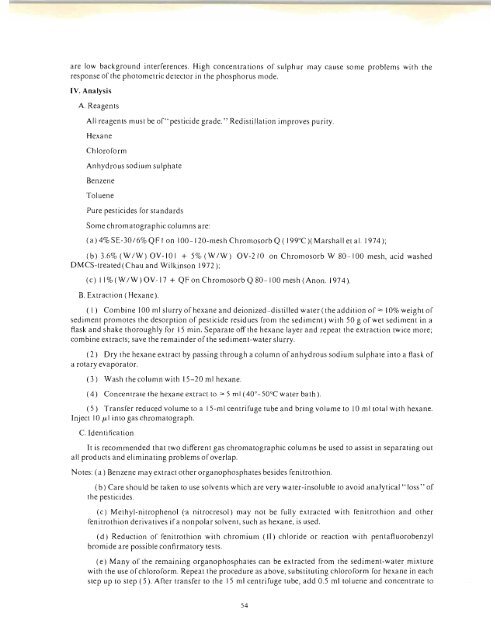You also want an ePaper? Increase the reach of your titles
YUMPU automatically turns print PDFs into web optimized ePapers that Google loves.
are low background interferences. High concentrations of sulphur may cause some problems with the<br />
response of the photometric detector in the phosphorus mode.<br />
IV. Analysis<br />
A. Reagents<br />
All reagents must be of "pesticide grade. " Redistillation improves purity.<br />
Hexa ne<br />
Chloroform<br />
Anhydrous sodium sulphate<br />
Benzene<br />
Toluene<br />
Pure pesticides for standards<br />
Some chromatographic columns are:<br />
(a) 4% S£-30/ 6% QF I on I 00-120-mesh Chromosorb Q ( I 99°C)( Marshall et a!. 1974);<br />
(b) 3.6% (W/ W) OV-IOI + 5% (W/W) OV-210 on Chromosorb W 80-100 mesh, acid washed<br />
DMCS-treated (Chau and Wilkinson 1972);<br />
(c) 11 % ( W / W) OV-17 + QF on Chromosorb Q 80-100 mesh (Anon. 1974).<br />
B. Extraction (Hexane).<br />
( I) Combine 100 ml slurry of hexane and deionized-distilled water (the addition of = 10% weight of<br />
sediment promotes the desorption of pesticide residues from the sediment) with 50 g of wet sediment in a<br />
flask and shake thorough Iy for 15 min. Separa te off the hexane layer and repeat the extraction twice more;<br />
combine extracts; save the remainder of the sediment-water slurry.<br />
(2) Dry the hexane extract by passing through a column of anhydrous sodium sulphate into a flask of<br />
a rotary evaporator.<br />
(3) Washthecolumnwith 15-20mlhexane.<br />
(4) Concentra te the hexa ne extract to = 5 ml (40°-50°C wa ter bath).<br />
(5) Transfer reduced volume to a 15-ml centrifuge tube and bring volume to 10 ml total with hexane.<br />
Inject 10,.,.1 into gas chromatograph.<br />
C. Identification<br />
It is recommended that two different gas chromatographic columns be used to assist in separating out<br />
all products and eliminating problems of overlap.<br />
Notes: (a) Benzene may extract other organophosphates besides fenitrothion.<br />
(b) Care should be taken to use solven ts which are very water-insolu ble to avoid analytical" loss" of<br />
the pesticides.<br />
(c) Methyl-nitrophenol ('a nitrocresol) may not be fully extracted with fenitrothion and other<br />
fenitrothion derivatives if a nonpolar solvent, such as hexane, is used.<br />
(d) Reduction of fenitrothion wi th chromium (II) chloride or reaction with pentafl uorobenzyl<br />
bromide are possible confirmatory tests.<br />
(e) Many of the remaining organophosphates can be extracted from the sediment-water mixture<br />
with the use of chloroform. Repeat the procedure as above, substituting chloroform for hexane in each<br />
step up to step (5). After transfer to the 15 ml centrifuge tube, add 0.5 ml toluene and concentrate to<br />
54

















